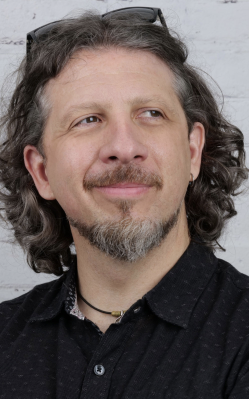Monday Mentors: Meet Rich Johnson, Assistant Director of Distance Education
Monday, November 20th, 2023

There’s a whole generation of students who owe at least some of their knowledge of Adobe Illustrator, Photoshop, InDesign, digital photography, and digital illustration to Rich Johnson.
He’s been working professionally as a graphic designer and creative director using Adobe software since 1997 and began teaching in PCA&D’s continuing education department just two years later. Since then, he’s taught in both a college setting as an adjunct professor and as a contracted corporate trainer. Johnson has a technical background in color correction and prepress focusing on output and complex graphic and image composites prepared for different press and online needs. In addition to design and production, he is a professional photographer and videographer working with businesses and individuals.
All of these perspectives are brought together into the classroom to address real-world scenarios and skills that can be applied to a plethora of career paths. And now, he uses those skills to work with both faculty and students to enhance online distance-learning opportunities.
You have created online teaching materials, and work with faculty to train them in distance learning: Can you share an example or two of using distance learning tactics and materials directly with students?
Rich Johnson: Central to my teaching philosophy both in person and online is to develop learning content that touches on as many learning modalities as possible and honors studies on attention span and engagement. A great deal of in-person teaching is lecture-based, which only meets auditory coupled with reading/writing. If a lab is included, now you have kinesthetic and social learning. In addition, if you bring in visual examples of each stage of understanding in stills and video, you have a wide range of people that you can catch in your learning net. My goal is to have written descriptions, slideshows, short incremental videos, lectures, and one-on-one lab interaction at each stage. Through authoring paired video content with strong self-paced materials, students will get multiple touches with any concept before progressing to the next level. Each stage is a prerequisite to the next.
My online model is to break up a class into multimedia self-study and practice, before in-person lecture expanding on those points and followed by a proof of mastery project with a rubric built to assess learning in that stage before progressing.
How do you see distance learning impacting what PCA&D has to offer, and how we offer it? Can you already see the impact?
RJ: Distance learning is an expansion of the reach for PCA&D to have students and faculty from all around the country attending classes and achieving degrees without needing to expand the physical building or provide housing for those students. Through course sharing with other institutions through Acadeum, colleges that don’t have enough students to fill a class or staff to teach a class can get resources through other institutions to provide the learning that students need. So, this arm of the institution has no boundary based on commuting or housing, and in the case of asynchronous learning, no boundary on time or schedule. Thinking for the working professionals, students in geographical regions without high education opportunities and those who need flexibility; distance education will give options from badging/credentials, certificates to degrees for those who might not have had the opportunity.
Does your work in this role, and teaching, impact your own creative process? How so?
RJ: I would say that one of the prime ways that teaching informs my creative process is in the reciprocal nature of sharing what I am learning from my professional work with students and discovering new perspectives from my students to apply to my work. The channel of discovery travels both ways. Plus, any time that a new challenge is presented, a new way of thinking and application of creative problem-solving leads to growth. I’ve been teaching as long as I have been in the design field, and I can’t imagine it any other way.
How do you and Holly Mosher work in tandem to support PCA&D instructors in the realm of distance education?
RJ: We provide support in technical challenges, classroom design, pedagogy, student needs, and creative problem-solving.
